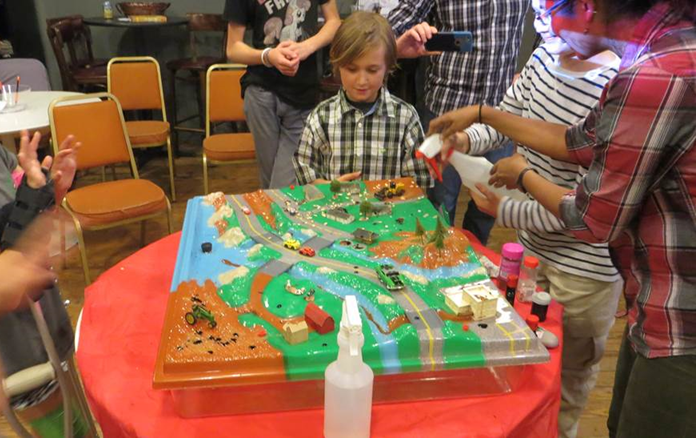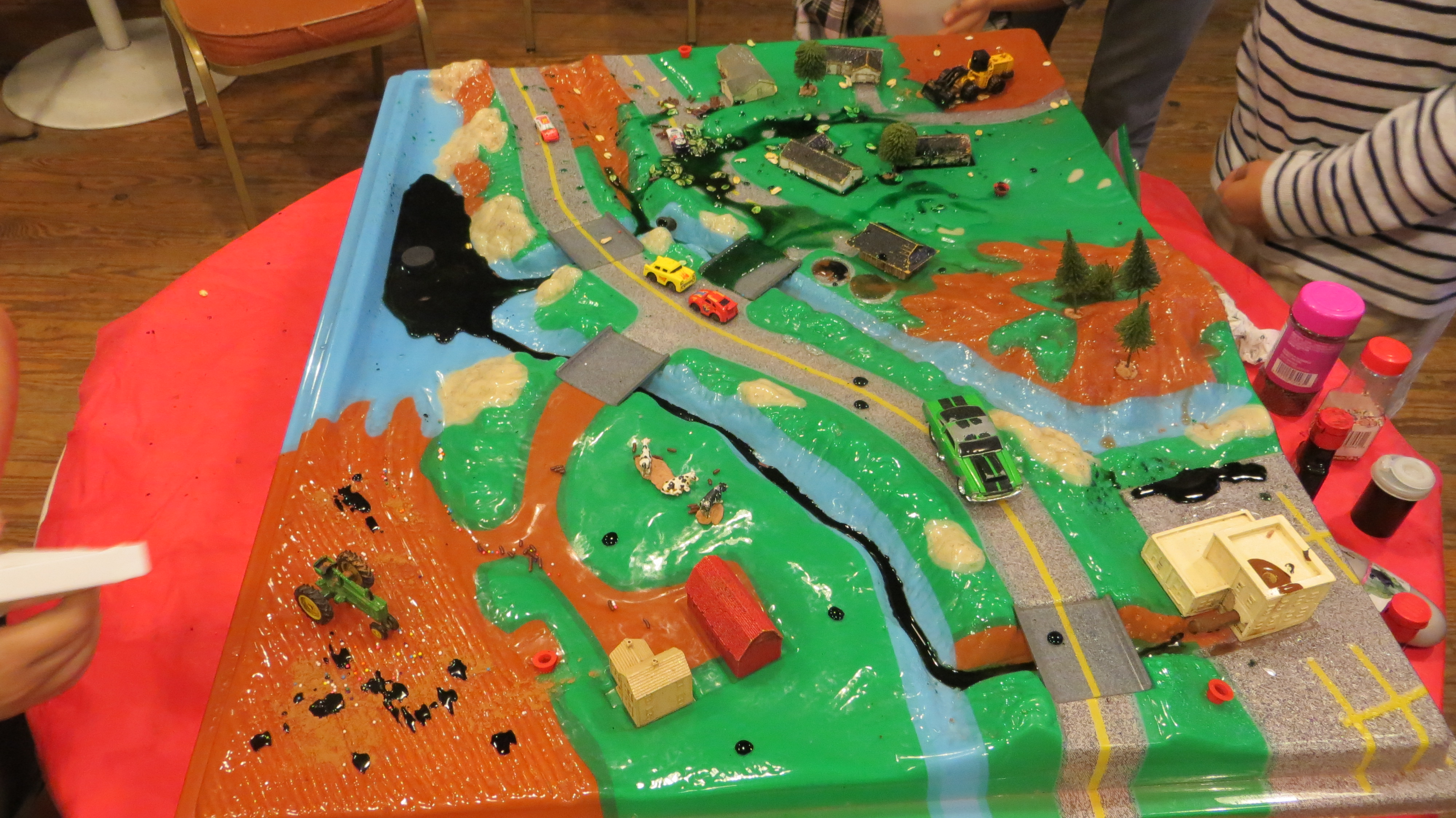Rasika Ramesh is a doctoral student in the School of Forestry and Wildlife Sciences at Auburn University. Her research focuses on modeling hydrology and water quality of headwater wetlands in Alabama’s Coastal Plain to understand how they function. In her spare time, she has a passion for conducting outreach related to watershed stewardship to young and old alike. Check out her recent effort at Mama Mocha’s in Auburn.

Rasika explaining the importance of viewing the landscape in terms of watersheds.
As part of Auburn University’s Science Café, I had the opportunity to talk to folks about “The Waters Around Us” – the importance of local waters and the need to conscientiously minimize threats to the quality and quantity of local waters. The first step towards water stewardship is to understand the concept of watersheds, and the impacts of different human activities on the waters within the watershed.
A watershed is the land area that drains to a particular point such as a stream, lake or river. Small streams, or wetlands have small watersheds, which collectively are a part of a larger whole which discharges into the coastal waterbodies. For instance, if you live in Lee County AL, you probably live in the Chewacla, Saugahatchee, Uphapee, Halawakee or Uchee watersheds. The Chewacla, Saugahatchee and Uphapee watersheds are part of the larger Tallapoosa River Basin which drains into the Tallapoosa River, while the Halawakee and Uchee watersheds are part of the Chattahoochee basin which drains into the Chattahoochee River. The Tallapoosa and Chattahoochee basins are part of larger basins – the Alabama-Coosa-Tallapoosa River Basin (ACT) and the Apalachicola-Chattahoochee-Flint River Basin (ACF) – which drain into the Gulf of Mexico. No matter where we are, we are always in a watershed!
To simplify the concepts of point and nonpoint source pollution in a watershed, I involved the audience through an interactive hands-on activity using an Enviroscape® model (www.enviroscapes.com). This is a 3D watershed model complete with typical land uses including a residential area, agricultural area, factory, construction site, waste water treatment plant, deforested hill, golf course, stream and a larger river. One can use different edible colored material to simulate pollutants from these land uses – cocoa powder for sediment from the field and construction site, chocolate sprinkles for animal feces, oats for litter, black food color for factory sludge and sewage, green food color for fertilizer, and so on.

Enthusiastic assistants simulate a rainfall-runoff event in the watershed.
The kids especially enjoyed sprinkling the watershed with animal feces! The kids used spray bottles to rain on the watershed simulating a rain storm and saw first-hand how the different pollutants end up in streams and rivers. Exclamations of “yew” and “gross” rang out frequently as the children contemplated drinking the blackened river water with all the pollutants from the watershed. While the kids had great fun trashing the watershed, the activity was a great way to remind everyone in the room about the reality of the consequences of our everyday activities on our local waters.

Yew! Runoff from a polluted landscape has fouled the river and the lake – what can we do?
Another very important aspect of water stewardship is water monitoring. Alabama is blessed with an amazing diversity of waterbodies. However, the state and/or agencies are ill- funded to monitor all waterbodies or monitor as often as needed. To be ensured of the quality and health of our waters, we can be water monitors as well, and not just leave the task up to other agencies or scientists. The Alabama Water Watch program is a great resource in this aspect – it is a citizen volunteer water quality monitoring program aimed at educating citizens on water issues and training citizens to use tools and techniques in order to gather credible water information. Through AWW anyone can get certified as a water monitor and learn to measure and identify contamination (bacteriological, water chemistry and stream biomonitoring). This data can then be entered in the AWW website to be used by agencies, scientists, and others involved with water resources management. Through a few slides I tried to familiarize people with the AWW website and passed brochures of the AWW program, and explained how I, as a graduate student, have utilized citizen data from the AWW website on numerous occasions. You can monitor the stream in your backyard, or your favorite swimming hole, or monitor waterbodies as a holiday pastime. Data collected by a certified AWW water monitor is credible and can be entered into the AWW database, which benefits us all!
